
http://www.iaeme.com/IJM/index.asp 189 editor@iaeme.com
International Journal of Management (IJM)
Volume 7, Issue 6, September–October 2016, pp.189–191, Article ID: IJM_07_06_021
Available online at
http://www.iaeme.com/ijm/issues.asp?JType=IJM&VType=7&IType=6
Journal Impact Factor (2016): 8.1920 (Calculated by GISI) www.jifactor.com
ISSN Print: 0976-6502 and ISSN Online: 0976-6510
© IAEME Publication
CONSTRUCTING A NEW FAMILY DISTRIBUTION
WITH METHODS OF ESTIMATION
Rawa M. Saleh
Department of Statistics, Economic and Administration College,
Al – Mustansryia University, Iraq.
ABSTRACT
A new parameter () is introduced to expand the family of two parameters Kumarasmy to
obtain new generated transmuted Kumarasmay distribution. The .., C.D.F and
moment of
this distribution are studied, parameters (,,) were obtained by moment and maximum
likelihood method, and regression estimator.
Key words: Transmuted Kumarasmay Distribution, Moment Estimators, Maximum likelihood
Estimator and regression estimator.
Cite this Article: Rawa M. Saleh, Constructing a New Family Distribution with Methods of
Estimation. International Journal of Management, 7(6), 2016, pp. 189–191.
http://www.iaeme.com/IJM/issues.asp?JType=IJM&VType=7&IType=6
1. INTRODUCTION
We can expand family of any distribution by introducing new parameter to the given p.d.f. In this paper we
work on expanding Kumarasmay distribution with two parameters (,) to another family using the
parameter () from some quadratic transformation on the given C.D.F [()] to obtain a new Cumulative
distribution function [()], then new generated transmuted .. [()]. Many researchers work on this
new mathematical formulation like Ashour and Eltehiwy (2013)
[5]
, studied a generalization of the Lomax
distribution so-called the transmuted Lomax distribution is proposed and studied. Various structural
properties including explicit expressions for the moments. The estimation of the model parameters is
performed by maximum likelihood method. We hope that the new distribution proposed here will serve as
an alternative model to the other models which are available in the literature for modeling positive real
data in many areas. Merovic (2013)
[11]
, generalize the Rayleigh distribution using the quadratic rank
transmutation map studied by Shaw et al. (2009) to develop a transmuted Rayleigh distribution. We
provide a comprehensive description of the mathematical properties of the subject distribution along with
its reliability behavior. The usefulness of the transmuted Rayleigh distribution for modeling data is
illustrated using real data. Aryal, G.R. and C.D. Tsokos (2009)
[2]
, studieda functional composition of the
cumulative distribution function of one probability distribution with the inverse cumulative distribution
function of another is called the transmutation map. In this article, we will use the quadratic rank
transmutation map (QRTM) in order to generate a flexible family of probability distributions taking
extreme value distribution as the base value distribution by introducing a new parameter that would offer

Rawa M. Saleh
http://www.iaeme.com/IJM/index.asp 182 editor@iaeme.com
more distributional flexibility. It will be shown that the analytical results are applicable to model real world
data.
2. THEORETICAL ASPECT
2.1. Transmuted Kumarasmay Distribution
The two parameters (,), p.d.f of Kumarasmay distribution is giving by;
(;,)=
(1−
)
0<<1 (1)
And the cumulative distribution function C.D.F is;
(;,)=1−(1−
)
(2)
We can obtain the new p.d.f called transmuted distribution by introducing parameter () using
quadratic transformation on the cumulative distribution function;
()=(1+)()−()
||≤1 (3)
Then;
()=(1+)()−2()() (4)
()=()(1+)−2()
()=
(1−
)
$(1+)−2%1−(1−
)
&'
=
(1−
)
$1+−2+2(1−
)
'
The new transmuted .. of Kumarasmay distribution is;
()=
(1−
)
$1−+2(1−
)
' (5)
And its C.D.F is;
()=(1+)$1−(1−
)
'−$1−(1−
)
'
=$1−(1−
)
'(1+−$1−(1−
)
')
=$1−(1−
)
'$1+(1−
)
' (6)
To derive the
moments about origin *
+
,
;
*
+
,
=-(
+
)=.
+
/
() (7)
=0
+1
/
(1−
)
$1−+2(1−
)
'
=(1−)0
+1
/
(1−
)
+20
+1
/
(1−
)
After some steps using transformation, we find;
Let 2=
→=2
4
5
=
2
4
5
2
*
+
,
=(1−)0 62
4
5
7
+1
/
(1−2)
1
2
4
5
2+20 62
4
5
7
+1
/
(1−2)
1
2
4
5
2

Constructing a New Family Distribution with Methods of Estimation
http://www.iaeme.com/IJM/index.asp 183 editor@iaeme.com
*
+
,
=(1−)0 2
8
5
/
(1−2)
2+20 2
8
5
/
(1−2)
2
*
+
,
= (1−)9:;< 6
+
+1,7+2 9:;< 6
+
+1,27 (8)
Equation (8) shows the
moments of this transmuted Kumarasmay distribution.
If ||≤1 we can form two equations (=1,2) from (*
+
,
) and equating (*
+
,
=
∑>
?8@
?A4
B
) to find
CD
EFG
,H
EFG
I.
When () is unknown, we can find three moment estimators of CD
EFG
,D
EFG
,H
EFG
I from solving
(*
+
,
=
∑>
?8@
?A4
B
) for (=1,2,3).
2.2. Maximum Likelihood Estimator
Let (
,
,…,
B
) be a random variables from .. in (5), then;
L=M(
N
)
B
NO
=
B
B
M
N
B
NO
M(1−
N
)
B
NO
M$1−
B
NO
+2(1−
N
)
' (9)
logL=Tlog+Tlog+(−1)Ulog
N
B
NO
+(−1)Ulog(1−
N
)
B
NO
+Ulog$1−+2(1−
N
)
'
B
NO
(10)
VlogL
V =T
+Ulog
N
B
NO
+(−1)U(−
N
)log(
N
)
C1−
N
I
B
NO
+U1
W
B
NO
VW
V
Where;
VW
V=2(1−
N
)
(−
N
)log(
N
)
=−2
N
log(
N
)(1−
N
)
VlogL
V =T
H+Ulog
N
B
NO
−(−1)UC
N
X
Ilog(
N
)
C1−
N
X
I
B
NO
−U2
N
log(
N
)(1−
N
)
(1−+2C1−
N
I
)
B
NO
=0 (11)
Solved numerically to obtain (H
EYZ
).
VlogL
V =T
+Ulog(1−
N
)
B
NO
+U2(1−
N
)log(1−
N
)
(1−+2C1−
N
I
)
B
NO
=0 (12)
Equation (12) can also be solved numerically to find (D
EYZ
).
Now we can restricted ||≤1 to estimate (,) only.
2.3. Proposed Regression Estimators (PRE)
Let
,
,
[
…….
\
be a random sample from P.D.F defined in (5), than

Rawa M. Saleh
http://www.iaeme.com/IJM/index.asp 184 editor@iaeme.com
2
N
=
N
(1−
N
)
(1−+2(1−
N
)
)
Since||≤1, using this restriction on λ, we can estimate the two parameters (α, β) by regression
estimators as follows:
Let
/
=
=−1
=β−1
N
=log
^
N
=(1−
^_
)
The model can be written as:
log2
^
=log()+(−1)log
^
+(−1)log
N
+log(1−λ+2
Na
)+b
N
Using least square procedure and according to
D
cd
=()
e
2f
We can use D
cd
to estimate H
/
,H
,H
After defining the variables
N
=log
^
N
=(1−
^_
)
Since |λ|≤1 we can restricted
[N
=(1−+2(
N
)
) By
When =1
[N
=2(
N
)
a
) (13)
Similarly for any value of λ we can compute
[N
=(1−λ+2λ(
N
)
a
) (14)
Now the final form of Regression Model is
2
g
h =log
/
+
log
N
+(
−1)log
N
+log
[N
+b
N
(15)
[N
is implicit function of (λ,
N
,β) and then (D
cd
) we use:
D=()
e
2f
()
e=
i
j
j
j
j
k
T U
N
U
N
U
[N
U
N
U
N
N
U
N
[N
U
N
U
N
[N
U
[N
l
m
m
m
m
n

Constructing a New Family Distribution with Methods of Estimation
http://www.iaeme.com/IJM/index.asp 185 editor@iaeme.com
2f =
i
j
j
j
j
k
U2
N
U
N
2
N
U
N
2
N
U
[N
2
N
l
m
m
m
m
n
According to the values of observation
N
and generated values of 2
N
(from C.D.F of this transmuted
probability distribution, we estimate the parameters by using regression estimator.
3. SIMULATION PROCEDURES
To find the estimator's (oL- ,opq:T;, <T r::sstpT) we perform simulation experiments using
Monte Carlo assuming that;
2 1.5 4
1 1.5 2
-0.5 -1 0.5 1
Table 1 Estimating values (=2,=1.5,=−0.5).
T
Method
MSE(
)
MSE(
)
30
MLE 2.771305 0.152198 1.968867 0.514225
MOM 2.840697 1.232696 2.000158 0.638284
REG 3.172072 0.713609 0.006161 0.701242
MLE MLE
60
MLE 3.383857 0.706872 0.0000872 0.715140
MOM 3.285207 1.072057 0.0003321 0.734638
REG 3.594134 1.156642 0.0038871 0.674751
MLE REG
90
MLE 2.816201 0.272663 0.0000464 0.367077
MOM 2.690945 0.372353 0.0002181 0.305427
REG 2.755554 0.417565 0.0015180 0.408384
MLE MOM
100
MLE 2.837422 0.331005 0.0000251 0.102811
MOM 3.098274 0.670246 0.0004870 0.238567
REG 2.817832 0.455094 0.0021080 0.086605
MLE REG

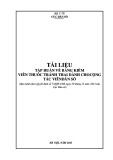
![Tài liệu tập huấn bảng kiểm viên thuốc tránh thai cho giảng viên tuyến tỉnh [Mới nhất]](https://cdn.tailieu.vn/images/document/thumbnail/2025/20250422/gaupanda088/135x160/3731745286813.jpg)
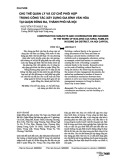

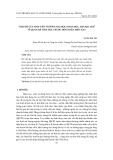
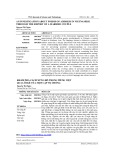
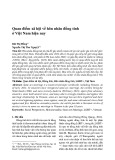

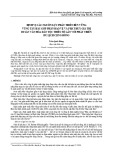
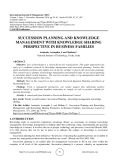


![Sổ tay Hướng dẫn truyền thông về lao động trẻ em [Mới nhất]](https://cdn.tailieu.vn/images/document/thumbnail/2025/20251114/kimphuong1001/135x160/7201763091001.jpg)







![Cẩm nang Thanh niên hành động [Mới nhất]](https://cdn.tailieu.vn/images/document/thumbnail/2025/20251017/kimphuong1001/135x160/1521760665202.jpg)




